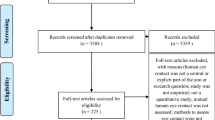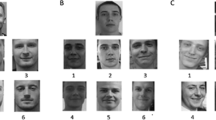Abstract
It has been shown that individuals with autism spectrum disorders (ASD) demonstrate normal activation in the fusiform gyrus when viewing familiar, but not unfamiliar faces. The current study utilized eye tracking to investigate patterns of attention underlying familiar versus unfamiliar face processing in ASD. Eye movements of 18 typically developing participants and 17 individuals with ASD were recorded while passively viewing three face categories: unfamiliar non-repeating faces, a repeating highly familiar face, and a repeating previously unfamiliar face. Results suggest that individuals with ASD do not exhibit more normative gaze patterns when viewing familiar faces. A second task assessed facial recognition accuracy and response time for familiar and novel faces. The groups did not differ on accuracy or reaction times.


Similar content being viewed by others
References
Adrien, J. L., Lenoir, P., Martineau, J., Perrot, A., Hameury, L., Larmande, C. et al. (1993). Blind ratings of early symptoms of autism based upon family home movies. Journal of the American Academy of Child and Adolescent Psychiatry, 32, 617–626.
Althoff, R. R., & Cohen, N. J. (1999). Eye-movement-based memory effect: A reprocessing effect in face perception. Journal of Experimental Psychology: Learning, Memory and Cognition, 25(4), 997–1010.
American Psychological Association. (1994). Diagnostic and statistical manual of mental disorders (4th ed.). Washington, DC.
Aylward, E., Bernier, R., Field, K., Grimme, A., & Dawson, G. (2004). Normal activation of fusiform gyrus in adolescents and adults with autism during viewing of familiar, but not unfamiliar, faces. Paper presented at the STAART/CPEA (Studies to Advance Autism Research and Treatment/Collaborative Programs for Excellence in Autism) NIH network meeting, May 17–20. Bethesda, MD.
Boraston, Z., & Blakemore, S. J. (2007). The application of eye-tracking technology in the study of autism. The Journal of Physiology, 581, 893–898.
Critchley, H. D., Daly, E. M., Bullmore, E. T., Williams, S. C., Van Amelsvoort, T., Robertson, D. M. et al. (2000). The functional neuroanatomy of social behaviour: Changes in cerebral blood flow when people with autistic disorder process facial expressions. Brain, 123, 2203–2212.
Dalton, K. M., Nacewicz, B. M., Johnstone, T., Schaefer, H. S., Gernsbacher, M. A., Goldsmith, H. H., Alexander, A. L., & Davidson, R. J. (2005). Gaze fixation and the neural circuitry of face processing in autism. Nature Neuroscience, 8(4), 519–526.
Damasio, A. R., Tranel, D., & Damasio, H. (1990). Face agnosia and the neural substrates of memory. Annual Review of Neuroscience, 13, 89–109.
Davies, S., Bishop, D., Manstead, A. S., & Tantam, D. (1994). Face perception in children with autism and Asperger’s syndrome. Journal of Child Psychology and Psychiatry, 35, 1033–1057.
Dawson, G., Meltzoff, A. N., Osterling, J., Rinaldi, J., & Brown, E. (1998). Children with autism fail to orient to naturally occurring social stimuli. Journal of Autism and Developmental Disorders, 28, 479–485.
Dawson, G., Webb, S. J., & McPartland, J. (2005). Understanding the nature of face processing impairment in autism: Insights from behavioral and electrophysiological studies. Developmental Neuropsychology, 27(3), 403–424.
Dawson, G., Webb, S. J., Wijsman, E., Schellenberg, G., Estes, E., Munson, J. et al. (2005). Neurocognitive and electrophysiological evidence of altered face processing in parents of children with autism: Implications for a model of abnormal development of social brain circuitry in autism. Development and Psychopathology, 17, 679–697.
Downing, P. E., Chan, A. W., Peelen, M. V., Dodds, C. M., & Kanwisher, N. (2006). Domain specificity in the visual cortex. Cerebral Cortex, 16(10), 1453–1461.
Faja, S., Aylward, E., Bernier, R., & Dawson, G. (2008). Becoming a face expert: A computerized face-training program for high-functioning individuals with autism spectrum disorders. Developmental Neuropsychology, 33, 1–24.
Gauthier, I., Skudlarski, P., Gore, J. C., & Anderson, A. W. (2000). Expertise for cars and birds recruits brain areas involved in face recognition. Nature Neuroscience, 3(2), 191–197.
Gauthier, I., & Tarr, M. J. (2002). Unraveling mechanisms for expert object recognition: Bridging brain activity and behavior. Journal of Experimental Psychology: Human Perception and Performance, 28(2), 431–446.
Gauthier, I., Tarr, M. J., Anderson, A.W, Skudanski, P., & Gore, J. C. (1999). Activation of the middle fusiform ‘face area’ increases with expertise in recognizing novel objects. Nature Neuroscience, 2(6), 568–573.
Grelotti, D. J., Gauthier, I., & Schultz, R. T. (2002). Social interest and the development of cortical face specialization: What autism teaches us about face processing. Developmental Psychobiology, 40, 213–225.
Haith, M. N., Bergman, T., & Moore, M. J. (1977). Eye contact and face scanning in early infancy. Science, 198(4319), 853–855.
Hall, G. B., Szechtman, H., & Nahmias, C. (2003). Enhanced salience and emotion recognition in Autism: A PET study. The American Journal of Psychiatry, 160, 1439–1441.
Haxby, J. V., Horwitz, B., Ungerleider, L. G., Maisog, J. M., Pietrini, P., & Grady C. L. (1994). The functional organization of human extrastriate cortex: A PET-rCBF study of selective attention to faces and locations. The Journal of Neuroscience, 14, 6336–6353.
Hubl, D., Bolte, S., Feineis-Matthews, S., Lanfermann, H., Federspiel, A., Strik, W. et al. (2003). Functional imbalance of visual pathways indicates alternative face processing strategies in autism. Neurology, 61, 1232–1237.
Janik, S. W., Wellens, A. R., Goldberg, M. L., & Dell’osso, L. F. (1978). Eyes as the center of focus in the visual examination of human faces. Perceptual and Motor Skills, 47, 857–858.
Kanner, L. (1943). Autistic disturbance of affective contact. Nervous Child, 2, 217–250.
Kanwisher, N. (2000). Domain specificity in face perception. Nature Neuroscience, 3(8), 759–763.
Kanwisher, N., McDermott, J., & Chun, M. M. (1997). The fusiform face area: A module in human extrastriate cortex specialized for face perception. The Journal of Neuroscience, 17(11), 4302–4311.
Kanwisher, N., & Yovel, G. (2006). The fusiform face area: A cortical region specialized for the perception of faces. Philosophical transactions of the Royal Society of London. Series B, Biological sciences, 29, 2109–2128.
Karatekin, C. (2007). Eye tracking studies of normative and atypical development. Developmental Review, doi:10.1016/j.dr.2007.06.006.
Klin, A., Jones, W., Schultz, R., Volkmar, F., & Cohen, D. (2002). Visual fixation patterns during viewing of naturalistic social situations as predictors of social competence in individuals with autism. Archives of General Psychiatry, 59(9), 809–816.
Klin, A., Sparrow, S. S., de Bildt, A., Cicchetti, D. V., Cohen, D. J., & Volkmar, F. R. (1999). A normed study of face recognition in autism and related disorders. Journal of Autism and Developmental Disorders, 29(6), 499–508.
Lord, C., Rutter, M., DiLavore, P. C., & Risi, S. (2000). Autism diagnostic observation schedule manual. Los Angeles, CA: Western Psychological Services.
Lord, C., Rutter, M., & LeCouteur, A. (1994). Autism diagnostic interview-revised: A revised version of a diagnostic interview for caregivers of individuals with possible pervasive developmental disorders. Journal of Autism and Developmental Disorders, 24, 659–685.
Marcus, D. J., & Nelson. C. A. (2001). Neural bases and development of face recognition in autism. CNS Spectrums, 6(1), 36–59.
Merin, N., Young, G. S., Ozonoff, S., & Rogers, S. J. (2007). Visual fixation patterns during reciprocal social interaction distinguish a subgroup of 6-month-old infants at-risk for autism from comparison infants. Journal of Autism and Developmental Disorders, 37(1), 108–121.
Nelson, C. A. (2001). The development and neural bases of face recognition. Infant and Child Development, 10, 3–18.
Neumann, D., Spezio, M. L., Piven, J., & Adolphs, R. (2006). Looking you in the mouth: Abnormal gaze in autism resulting from impaired top-down modulation of visual attention. Social Cognitive and Affective Neuroscience, 1(3), 194–202.
Osterling, J., & Dawson, G. (1994). Early recognition of children with autism: A study of first birthday home videotapes. Journal of Autism and Developmental Disorders, 24, 247–257.
Pelphrey, K. A., Sasson, N. J., Reznick, J. S., Paul, G., Goldman, B., & Piven, J. (2002). Visual scanning of faces in autism. Journal of Autism and Developmental Disorders, 32(4), 249–261.
Pierce, K., Haist, F., Sedaghat, F., & Courchesne, E. (2004). The brain response to personally familiar faces in autism: Findings of fusiform activity and beyond. Brain, 127(12), 2703–2716.
Pierce, K., Muller, R. A., Abmrose, G., Allen, G, & Courchesne, E. (2001). Face processing occurs outside the fusiform ‘face area’ in autism: Evidence from functional MRI. Brain, 124, 2059–2073.
Piggot, J., Kwon, H., Mobbs, D., Blasey, C., Lotspeich, L., Menon, V. et al. (2004). Emotional attribution in high-functioning individuals with autistic spectrum disorder: A functional imaging study. Journal of the American Academy of Child and Adolescent Psychiatry, 43, 473–480.
Puce, A., Allison, T., Asgari, M., Gore, J. C., & McCarthy, G. (1996). Differential sensitivity of human visual cortex to faces, letterstrings and textures: A functional magnetic resonance imaging study. The Journal of Neuroscience, 16(16), 5205–5215.
Puce, A., Allison, T., Gore, J. C., & McCarthy, G. (1995). Face-sensitive regions in human extrastriate cortex studied by functional MRI. Journal of Neurophysiology, 74, 1192–1199.
Rhodes, G., Byatt, G., Michie, P. T., & Puce, A. (2004). Is the fusiform face area specialized for faces, individuation, or expert individuation? Journal of Cognitive Neuroscience, 16(2), 189–203.
Rossion, B., Schiltz, C., & Crommelinck, M. (2003). The functionally defined right occipital and fusiform “face areas” discriminate novel from visually familiar faces. Neuroimage, 19, 877–883.
Schultz, R. T., Gauthier, I., Klin, A., Fulbright, R. K., Anderson, A. W., Volkmar, F. et al. (2000). Abnormal ventral temporal cortical activity during face discrimination among individuals with autism and Asperger syndrome. Archives of General Psychiatry, 57, 331–340.
Speer, L. L., Cook, A. E., McMahon, W. M., & Clark, E. (2007). Face processing in children with autism; effects of stimulus contents and type. Autism, 11, 265–277.
Spezio, M. L., Adolphs, R., Hurley, R. S. E., & Piven, J. (2007a). Abnormal use of facial information in high-functioning autism. Journal of Autism and Developmental Disorders, 37, 929–939.
Spezio, M. L., Adolphs, R., Hurley, R. S. E., & Piven, J. (2007b). Analysis of face gaze in autism using “Bubbles”. Neuropsychologia, 47, 144–151.
Tantam, D., Holmes, D., & Cordess, C. (1993). Nonverbal expression in autism of Asperger type. Journal of Autism and Developmental Disorders, 23, 111–133.
Trepagnier, C., Sebrechts, M. M., & Peterson, R. (2002). Atypical face gaze in autism. Cyberpsychology and Behavior, 5(3), 213–217.
van der Geest, J. N., Kemner, C., Verbaten, M. N., & van Engeland, H. (2002). Gaze behavior of children with pervasive developmental disorder toward human faces: A fixation time study. Journal of Child Psychology and Psychiatry, 43(5), 669–678.
Vuilleumier, P., Armony, J. L., Driver, J., & Dolan, R. J. (2001). Effects of attention and emotion on face processing in the human brain: An event-related fMRI study. Neuron, 30(3), 829–841.
Walker-Smith, G. J., Gale, A. G., & Findlay, J. M. (1977). Eye movement strategies involved in face perception. Perception, 6(3), 313–326.
Wang, A. T., Dapretto, M., Hariri, A. R., Sigman, M., & Bookheimer, S. Y. (2004). Neural correlates of facial affect processing in children and adolescents with autism spectrum disorder. Journal of the American Academy of Child and Adolescent Psychiatry, 34, 481–490.
Wechsler, D. (1997a). Wechsler adult intelligence scale (3rd ed.). San Antonio, TX: The Psychological Corporation.
Wechsler, D. (1997b). Wechsler memory scale (3rd ed.). San Antonio, TX: The Psychological Corporation.
Whiteley, A. M., & Warrington, E. K. (1977). Prosopagnosia: A clinical, psychological, and anatomical study of three patients. Journal of Neurology, Neurosurgery, and Psychiatry, 40, 395–403.
Wojciulik, E., Kanwishwer, N., & Driver, J. (1998). Covert visual attention modulates face-specific activity in the human fusiform gyrus: fMRI study. Journal of Neurophysiology, 79(3), 1574–1578.
Xu, Y. (2005). Revisiting the role of the fusiform face area in visual expertise. Cerebral Cortex, 15(8), 1234–1242.
Acknowledgments
We wish to thank the individuals and families who participated in this study. We also wish to thank James McPartland, Ph.D., who contributed his time and technical expertise during the initial stages of this project. This research was funded by a center grant from the National Institute of Mental Health (U54MH066399), which is part of the NIMH STAART Centers.
Author information
Authors and Affiliations
Corresponding author
Rights and permissions
About this article
Cite this article
Sterling, L., Dawson, G., Webb, S. et al. The Role of Face Familiarity in Eye Tracking of Faces by Individuals with Autism Spectrum Disorders. J Autism Dev Disord 38, 1666–1675 (2008). https://doi.org/10.1007/s10803-008-0550-1
Received:
Accepted:
Published:
Issue Date:
DOI: https://doi.org/10.1007/s10803-008-0550-1




